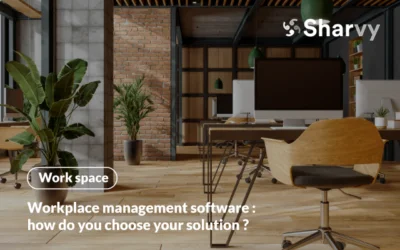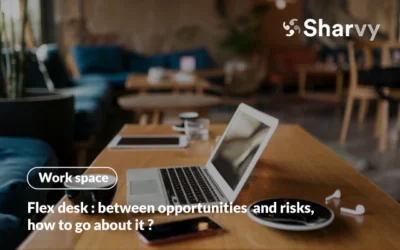Teleworking, increasing digitalization, the war for talent… There’s no doubt about it: for some years now, business leaders and HR departments have faced new challenges that foreshadow what tomorrow’s professional world will look like.
Today, nomadism is dramatically gaining ground within companies and gradually reducing the hold of the fixed workstation. Faced with this phenomenon, desk sharing is taking on a whole new meaning and inviting itself into our offices.
What is desk sharing?
As its name suggests, desk sharing means sharing offices within a company. Gone are the days of individual, dedicated desks replaced by desk sharing! As a result, employees no longer have their desks and are now free to set up wherever they like each morning. Spaces are being redesigned and optimized with this in mind.
Suppose desk sharing has gained ground in recent years. In that case, it’s primarily because companies are experiencing a considerable increase in property prices, an extraordinary health and financial crisis, and the massive use of teleworking.
As a result, businesses are finding themselves in a tricky situation, with many vacant offices for which they are paying a high price. That’s why desk sharing is so popular.
However, it should be distinct from flex desk and flex office. These are two very different terms.
Are you curious to know the main differences between flex office and desk sharing? Please read our article on the subject!
This way of organizing work encourages a new collaborative dynamic. What counts is not social status, which is linked to the size and location of an office, but the ability to work and create synergies.
However, this organization of work can only be transposed in some places. While it is ideally suited to many employees, such as sales staff, consultants, and freelancers, who come to the company from time to time before leaving to work elsewhere, there are always departments that will have their way of working. There will always be some departments, such as finance and HR, that will need individual, enclosed offices for obvious reasons of confidentiality.
The benefits of desk sharing for employees.
As well as reducing company costs, it is also a lever for performance and attracting future talent. There’s no doubt about it: millennials and Generation Z want to work for companies that align with their values, and sustainable development is their priority. For this reason, many companies opt for desk sharing : by reducing their office space, they can consume less energy. A smaller office space consumes less electricity and water and requires less maintenance.
The media focus on climate change has made companies more aware of the resources and energy they consume. Desk sharing makes it possible to commit to adopting more environmentally friendly practices, making it easier to recruit young talent.
At the same time, desk sharing fits in perfectly with hybrid working models, which offer employees the possibility of teleworking for a few days. As a result, your employees benefit from the advantages of hybrid working, such as a better work-life balance, greater flexibility, and increased productivity.
As a result, your teams enjoy greater autonomy, which increases employee satisfaction and loyalty.
What’s in it for the company?
- A better flow of information between employees
- An environment more conducive to exchanges and meetings between employees from different teams
- A stronger team spirit and the promotion of collaborative work
- Reconcile work performance, health, and well-being at work
- Optimisation of spaces & occupancy rate, allowing the creation of new ones (break rooms, cafeteria, hot desking areas, corpoworking spaces…)
- A reduction in office space and therefore costs (up to 25% savings on average).
However, it should be noted that these innovative spaces, where desk sharing can be set up, must also be accompanied by areas for concentration and silence. These are areas designed for employees who want to make a phone call, carry out a video conference, or enjoy a few hours of peace and quiet, undisturbed by any discussions.
How can you optimize your workspaces? Download our checklist and find out how to optimize your building’s access and security, the management of your workspaces, and the occupation, use, and layout of your premises.
How to implement desk sharing and make a successful transition?
Consider some points if you want to transition to desk sharing successfully. These include :
- Use reliable data on occupancy and the willingness of teams before making decisions on real estate strategy.
- Determine the “ideal” occupancy rate and desk-sharing ratio of your offices.
- Limit the size of open spaces so that you don’t have open-plan offices with hundreds of people, as your employees want to keep their peace and privacy.
- Inform managers and teams well in advance to prepare them for these changes.
- Equip the workstations to meet everyone’s needs: screen, keyboard, mouse, computer support, etc.
- Provide each employee with a locker so that they can store their documents, personal effects, etc.
- Digitalising this transformation with the help of a space reservation solution to accompany the employee on a daily basis, like Sharvy. The advantages of desk booking are numerous! This type of tool will also enable you to improve well-being at work and promote fairness within your company.
Want to find out more? Find out in this case study how the Sharvy application is used by the Institut de Recherche pour le Développement (IRD) to enable HRD staff to book an office before coming on-site.
How can a dedicated application help employees in this area?
For example, applications (such as Sharvy) are dedicated to desk sharing and supporting your employees. This application allows employees to reserve a workstation (desk booking) when they come on-site.
Once they have done this, the application’s algorithm assigns them a workstation according to their team assignment. From then on, if employees play along, the management of these workspaces is optimized. At the same time, attendance schedules are better organized, and the company has an overall view of how full its site is.
It should be noted that most of these applications integrate with various HRIS and invoicing tools (such as Lucca, Kelio, SAP, etc). In particular, to avoid double entries and potential errors. Sharvy can, for example, automatically block bookings for days off and teleworking for users. What’s more, if you want to charge for the use of space, Sharvy allows you to extract billing files detailing the bookings of each user.
In conclusion
Integrating desk sharing into modern workspaces is not just a physical reorganization but a shift towards more collaborative and flexible work environments. This approach, adopted by many startups and large companies, transforms the way work is done in offices, promoting creativity and optimizing the use of personal workspace. To successfully transition, it is crucial to design work environments that consider new work modes and the needs of each employee.
Want to learn more? Check out our latest articles!
Workplace management software : how do you choose your solution?
Faced with a wide choice of Workplace Management software, find out how to choose the right solution for you and its features!
New uses in the workplace : which ones should be favoured?
Discover five new ways of using your workplaces to meet the changing needs and expectations of your employees!
Flex desk : between opportunities and risks, how to go about it?
In this article, discover all our tips to avoid many disadvantages and make your transition to the flex desk successful.
Subscribe to our newsletter!
Resources
Contact us
+44 117 463 6990






